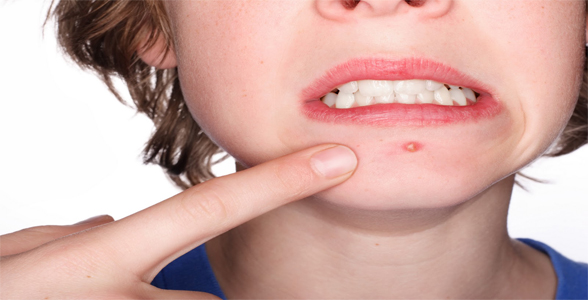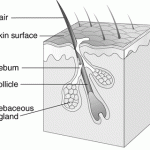What Causes Acne?
The exact cause of acne is unknown, but doctors believe it results from several related factors. One important factor is an increase in hormones called androgens (male sex hormones). These increase in both boys and girls during puberty and cause the sebaceous glands to enlarge and make more sebum. Hormonal changes related to pregnancy or starting or stopping birth control pills can also cause acne.
Another factor is heredity or genetics. Researchers believe that the tendency to develop acne can be inherited from parents. For
example, studies have shown that many school-age boys with acne have a family history of the disorder. Certain drugs, including androgens and lithium, are known to cause acne. Greasy cosmetics may alter the cells of the follicles and make them stick together, producing a plug.
Factors That Can Make Acne Worse
Factors that can cause an acne flare include:
- Changing hormone levels in adolescent girls and adult women 2 to 7 days before their menstrual period starts
- Oil from skin products (moisturizers or cosmetics) or grease encountered in the work environment (for example, a kitchen with fry vats)
- Pressure from sports helmets or equipment, backpacks, tight collars, or tight sports uniforms
- Environmental irritants, such as pollution and high humidity
- Squeezing or picking at blemishes
- Hard scrubbing of the skin
- Stress.
How Does Acne Develop?
Doctors describe acne as a disease of the pilosebaceous units (PSUs). Found over most of the body, PSUs consist of a sebaceous gland connected to a canal, called a follicle, that contains a fine hair. These units are most numerous on the face, upper back, and chest. The sebaceous glands make an oily substance called sebum that normally empties onto the skin surface through the opening of the follicle, commonly called a pore. Cells called keratinocytes line the follicle.
The hair, sebum, and keratinocytes that fill the narrow follicle may produce a plug, which is an early sign of acne. The plug prevents sebum from reaching the surface of the skin through a pore. The mixture of oil and cells allows bacteria Propionibacterium acnes (P. acnes) that normally live on the skin to grow in the plugged follicles. These bacteria produce chemicals and enzymes and attract white blood cells that cause inflammation. (Inflammation is a characteristic reaction of tissues to disease or injury and is marked by four signs: swelling, redness, heat, and pain.) When the wall of the plugged follicle breaks down, it spills everything into the nearby skin ? sebum, shed skin cells, and bacteria ? leading to lesions or pimples.
People with acne frequently have a variety of lesions, some of which are shown in the diagrams below. The basic acne lesion, called
the comedo (KOM-e-do), is simply an enlarged and plugged hair follicle. If the plugged follicle, or comedo, stays beneath the skin, it is called a closed comedo and produces a white bump called a whitehead. A comedo that reaches the surface of the skin and opens up is called an open comedo or blackhead because it looks black on the skin’s surface. This black discoloration is due to
changes in sebum as it is exposed to air. It is not due to dirt. Both whiteheads and blackheads may stay in the skin for a long time.
Things that make acne better
1. Fresh fruit, vegetables, nuts and seeds
Increase the variety of fresh fruit, vegetables, nuts and seeds in your diet to help get rid of your acne. The easiest way to do this is to create delicious smoothies and juices from greens and ripe fruit, have at least one salad every day — even just as a side dish — with your main meal, and snack on nuts and dried fruits. Brazil nuts and pumpkin seeds are fantastic for getting rid of acne because they contain selenium (Brazils) and zinc (pumpkin seeds), deficiencies in these minerals have been linked to acne.
2. Water
Drink plenty of water every day to help get rid of your acne. Aim to drink at least two litres of still mineral water. If the skin becomes dehydrated, dead skin cells are not effectively shed, which can lead to blocked pores and further acne.
3. Probiotics and prebiotics
Antibiotics destroy the bacteria in your digestive system, which can lead to poor digestion, constipation and reduced absorption of essential vitamins, minerals and nutrients — all of which can lead to more acne because your body isn’t able to get rid of waste effectively and toxins get expelled via the skin instead. If you have been taking antibiotics for your acne, it’s vital you replace the
“friendly” bacteria in your digestive system with a good quality probiotic, such as Nature’s Biotics.
Prebiotics are foods which help re-establish the good bacteria in the gut — these include honey, onions, artichokes and bananas. Taking a probiotic supplement and eating prebiotics foods will help restore the levels of beneficial bacteria that are destroyed by antibiotics and help get rid of your acne.



